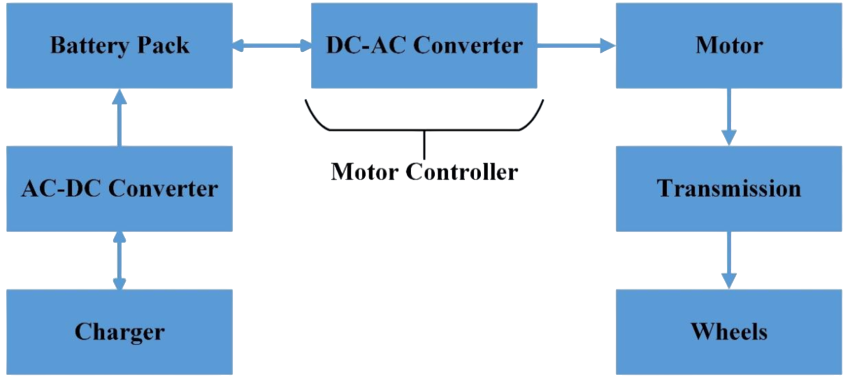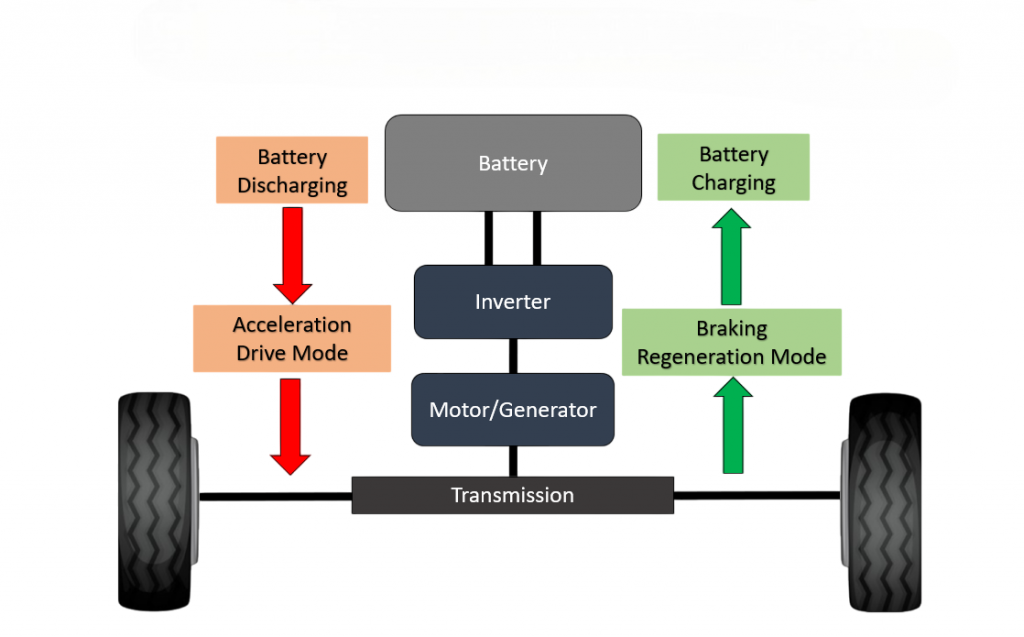
- Overview of EV Technology
- Components of Overview
- Battery Operations
- Power Inverter
- Electric Motor Drive
- Transmission System
- Regenerative Braking
- Thermal Management
- Charging System
- Energy Flow Cycle
- Real-life Driving Dynamics
- Summary
Overview of EV Technology (Expanded)
Because EV technology offers a high-performance, environmentally friendly substitute for conventional internal combustion engine (ICE) vehicles, it is revolutionising the worldwide automobile industry. EVs contribute to cleaner air and increased energy efficiency, and with Artificial Intelligence Training , they also help in removing tailpipe emissions and lowering dependency on fossil fuels. The shift to electric transportation has become both urgent and unavoidable because of growing environmental concerns and stricter government emission laws. This in-depth study examines the essential elements, guiding concepts, practical uses, and state-of-the-art developments propelling the development of contemporary EV technology.
Components of Overview
Electric vehicles, as part of the EV Industry Career , are built on a sophisticated architecture of interdependent systems that function cohesively to deliver smooth and efficient performance. The key components of EVs include:
- Battery Pack: Stores electrical energy used for propulsion.
- Electric Motor Drive: Converts electrical energy into rotational motion.
- Power Inverter: Converts DC from the battery to AC for the motor.
- Transmission System: Transfers torque to the wheels.
- Thermal Management System: Maintains optimal temperatures.
These components collectively define the core performance, reliability, and efficiency of an EV.
Battery Operations
The battery is the backbone of any EV. It determines the vehicle’s range, charging time, and longevity. The most common battery type used in EVs is the lithium-ion battery due to its superior energy density, lifecycle, and charge efficiency.

To provide the necessary voltage and capacity, electric car batteries, as seen in Tesla EV Battery Tech , are made up of cells organised in modules and packs in series-parallel configurations. The Battery Management System (BMS), which continuously monitors voltage, temperature, and current, is essential to guaranteeing safe operation. Important indicators like State of Charge (SOC) show how much battery energy is left, while State of Health (SOH) shows how the battery ages and loses capacity over time. To keep batteries operating at their best and avoid overheating, efficient thermal management using liquid or air-based cooling systems is crucial. Environmental conditions, charging habits, and charge cycles are some of the elements that affect battery degeneration.
Ready to Get Certified in Artificial Intelligence ? Explore the Program Now Artificial Intelligence Online Training Offered By ACTE Right Now!
Power Inverter
The power inverter is the interface between the battery and the motor. It converts DC power into AC using high-frequency switching techniques and also supports regenerative braking by converting AC back into DC.
- Functions of the Power Inverter
- DC-AC Conversion: Enables the use of AC motors.
- Pulse Width Modulation (PWM): Regulates motor speed and torque.
- Bidirectional Power Flow: Supports regeneration and grid interaction.
- Protection Features: Includes overload, short-circuit, and thermal protection.
Advanced inverters are compact, thermally efficient, and capable of real-time communication with the vehicle’s main control unit.
Electric Motor Drive
A vital part of contemporary electric vehicles, electric motors in EVs offer tremendous torque, seamless operation, and precise control. The two main varieties that are frequently utilised are Permanent Magnet Synchronous Motors (PMSM), which are frequently seen in high-end EVs due to their exceptional torque density and excellent efficiency, and Induction Motors (IM), which are reliable, affordable, and extensively utilised in Tesla vehicles. These motors provide a number of benefits, such as immediate torque for quick acceleration, high efficiency of up to 95% in ideal circumstances, a small and light design that lowers the total weight of the vehicle, and regenerative capabilities that improve energy economy. Advanced control algorithms, vector control strategies, and real-time sensor data further optimise motor drive systems, allowing the motor to smoothly adjust to changing road conditions and driver inputs.
To Explore Artificial Intelligence in Depth, Check Out Our Comprehensive Artificial Intelligence Online Training To Gain Insights From Our Experts!
Transmission System
EVs eliminate the need for complex multi-gear transmissions due to the wide torque range of electric motors. Most EVs use a single-speed transmission or direct drive system.
- Advantages of Simplified Transmissions
- Improved Efficiency
- Improved Efficiency
- Fewer Moving Parts
- Reduced Maintenance
Some performance EVs use 2-speed transmissions to improve acceleration and top speed. However, most consumer EVs prefer simplicity and reliability.
Regenerative Braking
Regenerative braking, enhanced with Artificial Intelligence Training , captures kinetic energy during deceleration and stores it back into the battery, reducing energy loss and wear on mechanical brakes.

- Key Features
- Energy Recovery: Improves overall range.
- One-Pedal Driving: Enhances control and convenience.
- Reduced Brake Maintenance: Minimizes pad wear.
Many EVs offer adjustable regen levels, allowing drivers to customize their driving experience for comfort or efficiency.
Thermal Management
Temperature control is vital for battery, motor, and electronics performance. Modern EVs employ sophisticated thermal management systems.
- Cooling Methods
- Air Cooling: Used in small or entry-level EVs.
- Liquid Cooling: Common in high-performance EVs for better heat dissipation.
- Heat Pumps: Provide efficient cabin and component heating/cooling.
- Charging: Energy enters the battery through OBC.
- Inversion: Inverter supplies AC power to the motor.
- Motion: Motor delivers torque to wheels via transmission.
- Usage: Systems like lighting and HVAC consume battery power.
- Braking: Kinetic energy returns to the battery through regeneration.
- Thermal Regulation: Maintains safe operating temperatures.
- Instant Throttle Response: No delay in acceleration.
- Quiet Operation: Absence of engine vibrations.
- Low Center of Gravity: Improved cornering stability.
- Advanced Driver-Assistance Systems (ADAS): Integrated features like lane-keeping and adaptive cruise.
Proper thermal management improves safety, prevents component degradation, and enhances comfort and battery life.
Looking to Master Machine Learning? Discover the Artificial Intelligence Expert Masters Program Training Course Available at ACTE Now!
Charging System
To connect to fast-charging networks and electric grids, electric vehicles need dependable and effective charging systems. Level 2 (240V AC) is commonly used in homes and public stations, Level 3 (DC Fast Charging) can deliver up to 80% charge in less than an hour, and Level 1 (120V AC) is appropriate for overnight home charging. The onboard charger (OBC) controls the conversion of AC to DC, keeps an eye on the charging procedure, connects to the grid, and guarantees interoperability with various power sources. In addition to proprietary systems like Tesla’s NACS, modern EVs frequently use standardised connectors like CCS and CHAdeMO. Furthermore, vehicle-to-grid (V2G) capabilities and smart charging platforms are new developments that enable dynamic interactions between automobiles and the electrical grid for improved energy management and efficiency.
Preparing for Artificial Intelligence Job Interviews? Have a Look at Our Blog on Artificial Intelligence Interview Questions and Answers To Ace Your Interview!
Energy Flow Cycle
Understanding energy flow clarifies how an EV functions under various conditions:
Smart energy management systems optimize this flow for performance, range, and efficiency.
Real-life Driving Dynamics
EVs redefine the driving experience with seamless acceleration, minimal noise, and refined handling. Key dynamics include:
The regenerative braking also adds a unique dimension to driving, especially in urban environments.
Summary
EV technology, combined with Artificial Intelligence Training , integrates advanced mechanical, electrical, and digital systems to create clean, smart, and high-performance vehicles. Each component from the battery to the motor, inverter, and thermal systems plays a vital role in overall functionality and efficiency. With ongoing innovations in battery chemistry, fast charging, AI-driven controls, and smart grids, EVs are rapidly evolving into the default mode of transportation. As infrastructure grows and technology matures, the EV landscape promises a sustainable and exciting future for mobility enthusiasts and everyday consumers alike.




